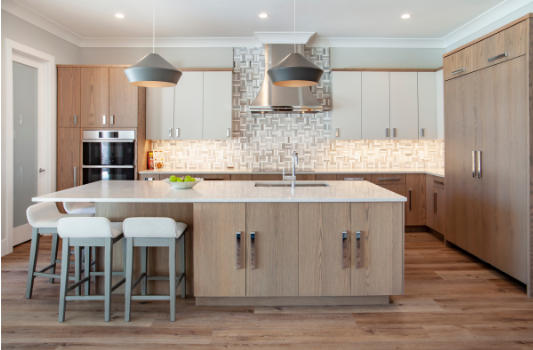The world of kitchen design is constantly evolving, and one of the most significant driving forces behind this transformation is technology. With advancements in automation, connectivity, and sustainability, kitchens of the future are set to revolutionize the way we cook, interact, and experience our culinary spaces. In this blog post, we will explore the exciting possibilities that lie ahead and how technology will shape kitchen design in the future.
The Intersection Between Technology and Kitchen Design

Design by Patricia Davis Brown Designs, LLC.
-
Smart Appliances for Enhanced Efficiency
The future kitchen design will be equipped with intelligent appliances that seamlessly integrate into our daily lives. Smart refrigerators will not only keep our food fresh but also offer inventory management and meal planning assistance. These refrigerators will be connected to the internet, enabling users to access recipes, order groceries, and monitor their contents remotely.
In addition, smart ovens and cooktops will bring precision cooking to a whole new level. Utilizing sensors and connectivity, they will automatically adjust the temperature, cooking time, and humidity to ensure perfect results every time. With voice and gesture control, the cooking process will become more intuitive and hands-free.
-
Sustainable Solutions for a Greener Kitchen
As sustainability becomes increasingly important, technology will play a vital role in creating eco-friendly kitchens. Energy-efficient appliances will become the norm, reducing power consumption and minimizing our carbon footprint. Additionally, smart water management systems will help conserve water by monitoring usage and detecting leaks, promoting responsible consumption.
Renewable energy sources such as solar panels and induction cooktops will become more accessible, allowing homeowners to generate their electricity and cook with greater efficiency. Moreover, innovative recycling and waste management solutions will be integrated into kitchen design, making it easier for users to sort and dispose of waste responsibly.
-
Integration of Augmented Reality (AR) and Virtual Reality (VR)
Augmented Reality (AR) and Virtual Reality (VR) technologies have immense potential to transform the way we design and visualize kitchens. AR will enable customers to preview different kitchen layouts, materials, and finishes in real-time, right in their own homes. They can simply use their smartphones or tablets to overlay virtual objects onto their existing kitchen, helping them make informed decisions before starting the renovation process.
On the other hand, VR will offer immersive experiences, allowing homeowners to explore their future kitchens in a virtual environment. They can walk through their dream kitchen, test different lighting options, and even interact with virtual appliances. This technology will empower customers to customize their spaces with confidence, ensuring the final result meets their expectations.
-
Multi-Functional and Modular Designs
With the rise of compact urban living, kitchens will need to adapt to smaller spaces. Technology will drive the development of multi-functional and modular designs that maximize efficiency and usability. For example, kitchen islands will be equipped with retractable countertops, transforming them into dining tables or workstations when needed.
Modularity will allow homeowners to easily reconfigure their kitchens to suit their changing needs. Cabinets and storage units will feature adjustable shelving and movable partitions, providing flexibility and optimal space utilization. By embracing these flexible designs, kitchens will become adaptable spaces that can accommodate various activities and lifestyles.
-
Enhanced Safety and Hygiene Measures
In light of recent global events, hygiene and safety have become paramount concerns. Future kitchens will incorporate advanced technologies to ensure cleanliness and minimize the spread of germs. Self-cleaning surfaces and appliances with antimicrobial properties will become standard, reducing the need for frequent manual cleaning.
Voice-activated faucets and motion-sensing lights will eliminate the need for physical contact, maintaining hygiene while enhancing convenience. Additionally, air filtration systems will be integrated into kitchen design, purifying the air and removing harmful particles and odors.
Conclusion
The future of kitchen design holds tremendous potential for transforming our culinary spaces into efficient, sustainable, and user-friendly environments.
Other posts you might enjoy:
Get Your Geek On with Smart Home Technology
How Important Is Technology for the Future in Home Design?
Home Lighting Design: How Technology Created a New Atmosphere





